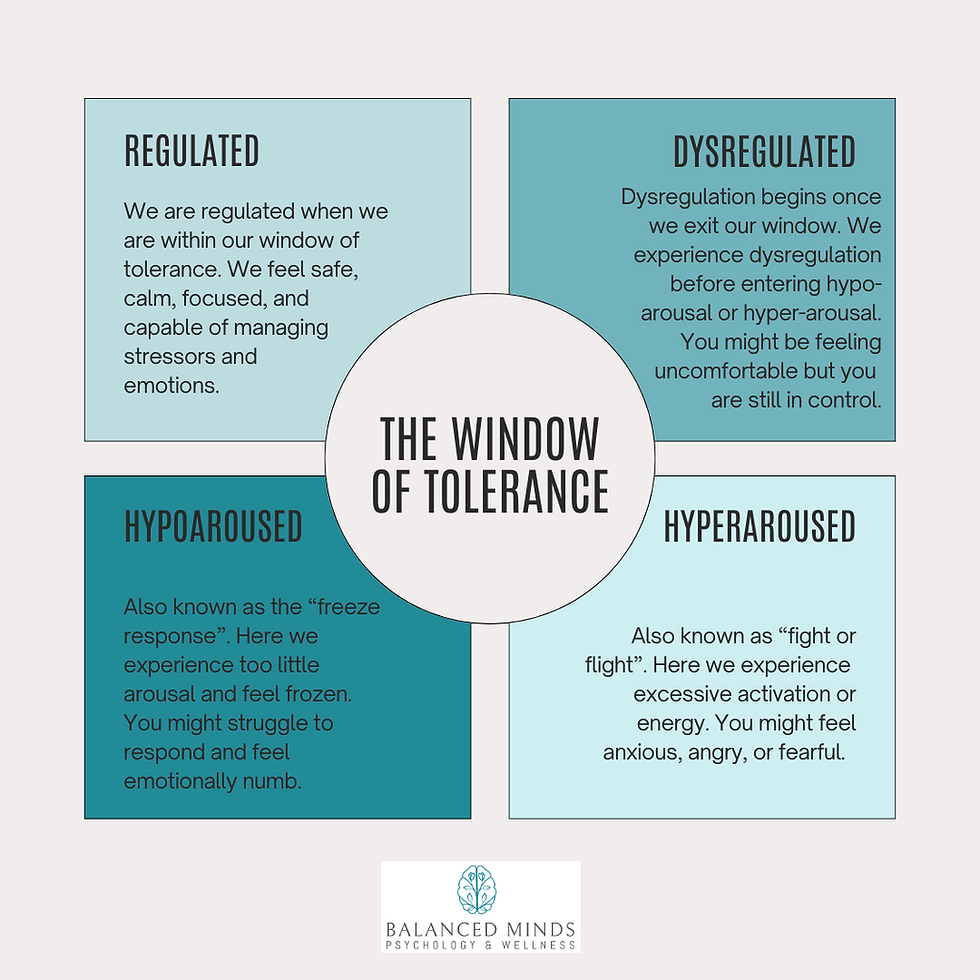What is the Window of Tolerance?
- Emily Warren
- Jul 22, 2024
- 3 min read
Updated: Jul 22, 2024
Ways you can identify the zones of regulation, practical skills for coping with dysregulation, and ways to expand your window of tolerance.

The Window of Tolerance is the space that we feel comfortable, regulated, and safe. In this window we feel equipped to handle daily life stressors without anxiety, fatigue, or feeling out of control. This is the optimal zone of arousal in which a person can function and deal with the demands of everyday life. It is useful to understand the window of tolerance because once we start to recognize dysregulation we can take action. The window of tolerance is a helpful tool to help us begin to understand when we feel overwhelmed so that we can utilize coping skills to return to our window.
For those of us who encounter regular stress, trauma, or have other mental health conditions it might be hard to remain in this optimal window. When we encounter stress or trauma we leave our window of tolerance, this is when we begin to experience the fight or flight response. If it is not possible to fight or flee, our bodies fall into a freeze state. Our bodies react defensively in efforts to keep us safe; this is a normal response when we are put in unsafe situations. Trauma and stress can stick with us and these responses can still be triggered long after the events have passed.

Dysregulation:
Dysregulation occurs when we start to exit our window of tolerance. You might feel uncomfortable or anxious, but you are still in control. Once we pass the point of dysregulation our bodies' defenses begin to take over; this is where the fight, flight, or freeze responses can happen. There are two states known as hyper-arousal and hypo-arousal that happen when we become dysregulated. In those two states you can experience a variety of symptoms and emotions.
Hyper-arousal:
Hyper-arousal is characterized by activation and typically high energy feelings such as anxiety, anger, and overwhelm. In this state you might experience symptoms like:
Anxiety
Panic
Overwhelm
Feeling out of control
Hyper-vigilance
Anger
Tension
Hypo-arousal
Hypo-arousal is characterized by too little arousal and can be seen as the opposite as hyper-arousal. A freeze response causes symptoms like:
Numbness
A feeling of “shutting down” and exiting the present moment
Brain fog
No distinct feelings
Having little to no energy
Feelings of shame or guilt
Dissociation
Below are some coping skills you can try out when you exit your window of tolerance!


Hyper-Aroused:
Progressive Muscle Relaxation
Mindfulness of current emotions
Communicating emotions and advocating for personal needs
Take some personal space to regulate
Try calming affirmations
Try breathing
Utilize mindfulness and relaxation skills
Hypo-Aroused:
Practice mindfulness
Movement or exercise
Try a body scan
Engage your senses
Try the 5, 4, 3, 2, 1 grounding activity
Nature observation or mindfulness walk
Practice gratitude and acceptance
In order to expand your window of tolerance you might consider:
Recognizing patterns of dysregulation
Building awareness of symptoms
Utilizing coping skills
Engaging in self-care
Practicing self-regulation when experiencing symptoms
Leaning on social support
Practice acceptance
Physical activity
Journaling or writing things out
Increasing mindfulness practices
Build resilience and foster overall wellness
Reducing shame and increasing positive emotions
Labeling and understanding your emotions
Challenge negative thoughts
Consulting with a professional for support with processing underlying trauma, managing anxiety, and for help with implementing these interventions into daily life.
On the path to growth and recovery it is expected to deviate from our window of tolerance. This knowledge allows you to expand your window of tolerance and to implement useful coping skills that can help when dysregulation occurs.
When to seek additional support:
Understanding and widening your personal window of tolerance can be challenging, but incredibly rewarding. Reclaiming your day to day life, improving your relationships, and managing stress, anxiety, or trauma can improve overall wellbeing. If you are facing consistent symptoms of dysregulation and feeling stuck consulting a mental health professional is advisable. A therapist can offer tailored interventions for coping and identifying underlying stressors and triggers while facilitating a deeper healing process. Additionally, a mental health professional can address other elements of your mental health that might be contributing to these symptoms.
At Balanced Minds Psychology & Wellness we specialize in assisting individuals navigating life’s challenges. To learn more about me and the services I provide, checkout my profile. If you are ready to start the therapy process, contact us today to start a free consultation.


Comentarios